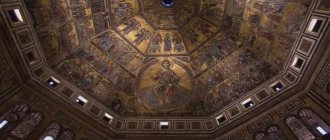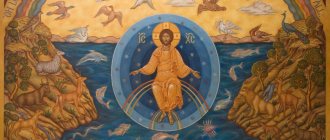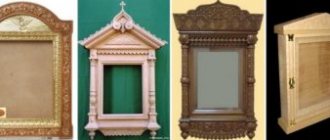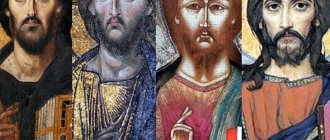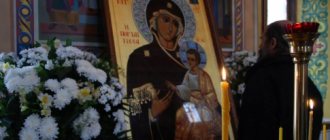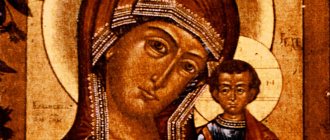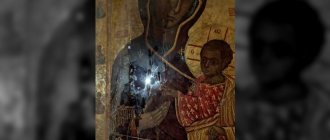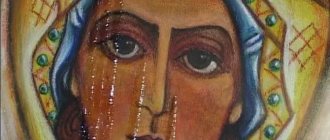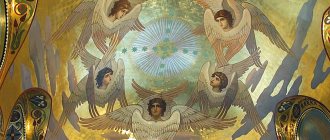Saint Christopher of Lycia, Miraculous eruption of the prophet Jonah from the mouth of a whale, Symbol of Faith, New Testament Trinity “Fatherland”, Council of Chinese Martyrs.
Go to Table of Contents.
Please note: images are clickable.
Determination of authorship
In ancient times, masters in the field of iconography were called isographers. It was believed that these people received their gift from God. They are chosen and worthy of their title. Until the beginning of the 18th century, isographers did not leave their signatures on iconographic images. It was believed that they were the Lord's mediators on earth. And it is the Lord who creates unique images with their hands.
Despite this circumstance, the names of several outstanding icon painters have become known to modern humanity. These are Andrei Rublev, Theophanes the Greek, Gregory, Dionysius, Alypius, etc. The most expensive icons belong to the brushes of these icon painters. The images of these isographs are unique and inimitable. They are kept in state museums and galleries. Anyone can see them. Moreover, according to surviving chronicles, the Byzantine artist Theophanes the Greek was engaged in painting several Russian churches. There are many icons of other, unknown authors. They are no less valuable.
Experts generally determine authorship by technique and writing style. Many icon painters signed the names of icons or the name of the saint depicted on them. This factor plays a huge role in determining the author of the work.
The creators of the most expensive icons in the world have long been known to mankind. The cost of an antique image directly depends on the fame of the icon painter.
Criteria for evaluating antique images
An antique is an old thing that has a high market value. An entire team of specialists with extensive experience in this field often works to evaluate antique icons. If a person is the owner of an ancient icon painting, he simply needs to know the market value of this item. Otherwise, when selling the icon, the owner will receive a relatively smaller amount. How to determine the age of an icon? This question interests many collectors. After all, this aspect plays a decisive role in determining the cost.
Market value depends on several important factors:
- time of writing, that is, age;
- author of the image;
- the presence or absence of a salary and precious stones;
- size;
- presence of marks on the back of the product;
- external condition;
- Is the product subject to restoration?
Settings were often used to decorate ancient icons. More valuable are the icons in a gold frame. Less often you can find images with precious stones. Icons in a silver frame also have a fairly high cost. There are cases when a precious frame is worth more than the iconographic image itself.
In addition to all the criteria described above, the cost is influenced by the plot of the image and miraculous properties.
Symbol of faith.
At the very beginning of the birth of Christianity, back in 325, at the first Ecumenical Council in Nicaea, a prayer was adopted for veneration - the “Symbol of Faith”, which contains a brief and understandable statement of the dogmas of Orthodox teaching. It is believed that the first spiritual image of an unusual and unique icon called the “Symbol of Faith” was painted at the beginning of the 15th century AD, and several decades later, it appeared in Russia. In 1489, this icon was personally transferred to the Annunciation Cathedral of the Moscow Kremlin by the Russian prince monk Vasily Ivanovich Mamyrev. Unfortunately, this icon was lost and was not preserved for posterity. In the 17th century, several copies of the “Symbol of Faith” icon were created on Russian soil, which became widespread throughout Great Rus'. At the same time, the image of the “Symbol of Faith” icon appears in the temple paintings of the Archangel Cathedral of the Moscow Kremlin and the Moscow Church of Gregory of Neocaesarea. For the “Symbol of Faith” icon, the Church of Christ has not established a special day for its veneration, due to the great rarity of this icon.
Traditional composition of icon stamps. Top row (from left to right):
1. Creation of the world.
I - “I believe in one God, the Father Almighty, Creator of heaven and earth, visible to all and invisible.”
2. Transfiguration of the Lord.
II - “And in one Lord Jesus Christ, the only Son of God, begotten of the Father before all ages; Light from Light, true God from True God, begotten, uncreated, consubstantial with the Father, to Whom all things were.”
3. Annunciation. Christmas.
III - “For our sake, man and our salvation came down from heaven and became incarnate from the Holy Spirit and the Virgin Mary, and became human.”
4. Crucifixion.
IV - “He was crucified for us under Pontius Pilate, and suffered and was buried.”
Second row:
5. Resurrection. Descent into hell.
V - “And he rose again on the third day according to the Scriptures.”
6. Ascension.
VI - “And ascended into heaven, and sits at the right hand of the Father.”
7. Last Judgment.
VII - “And again the one who comes will be judged with glory by the living and the dead, and His Kingdom will have no end.”
8. Descent of the Holy Spirit.
VIII - “And in the Holy Spirit, the Lord, the Life-Giving One, who proceeds from the Father.”
Bottom row:
9. People listen to the prophecy about the coming of the Lord.
VIII - “Let us worship and glorify those who are with the Father and the Son, who spoke the prophets.”
10. The apostles baptize people.
IX and X - “Into one Holy, Catholic and Apostolic Church. I confess one baptism for the remission of sins.”
11. Resurrection of the dead on the day of the Last Judgment.
XI - “I hope for the resurrection of the dead.”
12. Vertograd Prisoner - Heavenly Jerusalem
XII - “And the lives of the next century. Amen".
New Testament Trinity "Fatherland".
The Orthodox image on the icon “Trinity of the New Testament” Fatherland is unique and majestic, as it depicts the trinity of the True God in a special way. This image is based on the words from Holy Scripture that Jesus Christ said: “I and the Father are one; he who saw me saw the Father.” The Holy Spirit was sent down to the Apostles of Jesus Christ, after which they could speak in different languages and perform all sorts of miracles. No one knows exactly how and when the icon “New Testament Trinity” Fatherland appeared in Russia, there are also many versions about its authors, it is believed that the image was created by Novgorod masters of icon painting, but these are only guesses, exact data does not exist. It is only known that the development of this image began at the end of the 16th - beginning of the 17th centuries. In our time, the image has gained particular popularity, both among believers and in the Orthodox Church, so icons of the Holy Trinity continue to be created, and in many churches there are paintings of the image of the New Testament Trinity. In front of this icon, it is appropriate to pray for strengthening in the Christian faith, for everything that worries you physically and spiritually, for all the difficulties and problems that trouble your soul and heart, to ask for forgiveness for sins committed, and also to read confessional prayers. Celebrations in honor of the Holy Trinity by the Church of Christ are celebrated on the fiftieth day after the most important Christian holiday - the Resurrection of Christ.
How to sell an icon?
Any Christian believer, if he needs to sell an ancient icon, begins to be tormented by doubts. An Orthodox priest will help in this matter. The Church does not ban the sale of iconographic images. This action is not a sin.
If a person is deeply unbelieving, then the only question is whether there is a buyer. For a profitable sale, it is better to contact trusted antique stores. It is unlikely that you will be able to find a buyer on your own. Not every collector will want to deal with an unverified seller.
From all of the above we can conclude that an antique icon is a special thing. It not only carries a deep spiritual meaning, but also has a high market value. A person who owns such a work of art must decide for himself: to sell the icon or leave it at home and pass it on from generation to generation as a family heirloom.
Fortunately, the Russian Federation contains more than 30 of the most expensive icons known today.
“She who grieves for the little ones who are slain in the womb”
This rare image of the Blessed Virgin Mary appeared not so long ago. It was written in Ukraine, where the clergy first took the initiative to hold processions and prayers for children killed in the womb.
The icon depicts the Queen of Heaven and the Infant God crying over the soul of a child brought to the divine throne by an angel.
“The Blessed Star”
The authorship of the icon is attributed to the icon painter A.I. Kazantsev. The rare image was created in 1700 and placed in Murom in the Church of the Nativity of the Virgin.
Here the Mother of God is depicted standing with the Savior in her arms against the backdrop of the sun. The rays of the sun are separated from each other by stamps depicting various gospel events. On earth, saints bow to the Queen of Heaven and the Lord with prayer.
Cathedral of Chinese Martyrs.
The plot of this icon dates back to the very beginning of the 20th century. The events that took place in China are striking in their cruelty, because no one even guessed that this could happen in civilized times. In China in 1900, thousands of Christians of various denominations were killed, among them were 222 people of Chinese nationality who professed the Orthodox faith. On the day that Christians suffered martyrdom, posters appeared on the streets of Chinese cities calling for the killing of Christian foreigners. Massacres took place in the capital of the state - Beijing, when the created detachments of Buddhist nationalists killed Christians, cut off their heads, ripped open their bellies, burned them in their own houses and on bonfires outside the city. Among those who suffered for the faith of Christ were 222 Chinese martyrs, whose spiritual mentor was a Chinese priest, Father Mitrofan-Ji. They were all tortured and then executed, each in a different way, but for all of them the death was painful. Before repose before the Lord, the Chinese martyrs told their tormentors that it was not painful to suffer for Christ. The icon “Holy Chinese Martyrs” is very rare, therefore the Orthodox Church has not established a special day of veneration for it.
Continuation of the article: part 3.
Features of antique paints
An important factor is the study of paints. Antique icons of the 6th century, which have survived to this day, are painted with beeswax-based paints. In Rus', masters used tempera. This is an egg yolk based paint. Such iconography can be distinguished with the naked eye. Unlike oil paintings, tempera is more strict and schematic.
Authenticity of the iconographic image
Before assessing the value of an icon, it is necessary to determine its authenticity. Any specialist can recognize an ordinary fake. But to determine a high-quality copy, an examination will be required. People have long learned to paint antique images using certain techniques. The most difficult thing is to determine the authenticity when an ancient icon is completed by the hand of a younger master. In this case, the examination is carried out in a laboratory using special equipment. They study the base of the icon, the soil, and possible interventions.
“Mammal”
This image of the Mother of God was for a long time in the Holy Land in the Lavra of St. Savva the Sanctified. When Saint Sava the Serbian visited Jerusalem and Palestine several centuries later, according to the will of the founder of the monastery, he was blessed with this icon on his return journey.
Saint Sava brought this miraculous icon to the Hilandar monastery on Mount Athos and left it on the Holy Mountain. The image is also known for its unusual iconography and several miraculous lists.
The miraculous eruption of the prophet Jonah from the mouth of a whale.
The Orthodox image “The miraculous eruption of the prophet Jonah from the mouth of a whale” is a unique icon of great rarity, the plot of which is based on an Old Testament event that occurred in the 8th century BC. One day, the prophet Jonah heard the voice of God, commanding him to go to the country of Assyria and call its inhabitants, who committed all sorts of atrocities, to repentance before God. The prophet Jonah disobeyed the Lord and snuck onto a fishing ship in the hope of sailing away from Assyria. To admonish the prophet Jonah, the True God commanded a large whale to swallow him. Jonah spent three days in the belly of the huge Whale, deeply repented and sincerely prayed to the Lord so that the Almighty would save him. The Heavenly Father heard Jonah's spiritual prayer, and on the third day the whale spewed the prophet onto land. An example from the life of the Old Testament Prophet Jonah shows us mortals that for the True God nothing is impossible, this is shown in this icon, very unusual, but no less significant in Orthodoxy. The Almighty will certainly hear everyone who calls on him, will not leave us with his mercy, will help us in all matters and endeavors, will guide us on the true path and strengthen us in the Christian faith, the main thing is not to abandon the path destined for us. The Orthodox Church of Christ celebrates in honor of the prophet Jonah once a year - on October 5.
